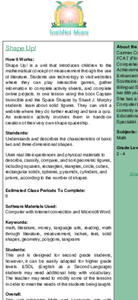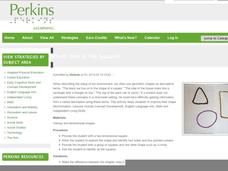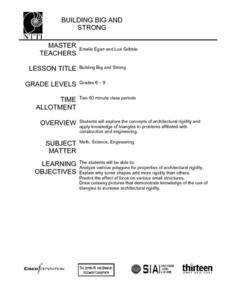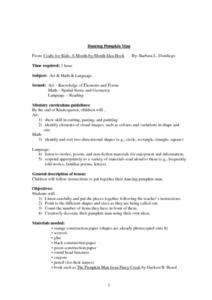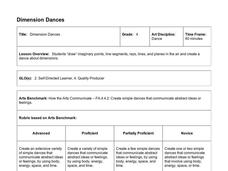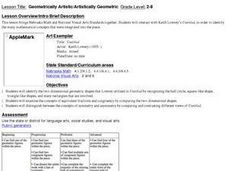Curated OER
Art--"Paper Pasting"--Doing Collage
In this art worksheet, students read a 1 page article on the history or art, prepare their background to making a collage, gather basic shapes, create their collage and then add in the finishing touches to them.
Curated OER
Expressing Emotions Through Art Lesson 4: Everybody Celebrates
Students examine how feelings of caring and working together can be expressed in works of art, and define the terms two-dimensional and three-dimensional. They design and create celebratory hats using three-dimensional paper techniques.
Curated OER
Expressing Emotions Through Art Lesson 3: Everybody Works Together
Students examine works of art that convey the idea of working together and analyze how artists use foreground, middle ground, and background. They use two-and three-dimensional materials to create a work of art.
Curated OER
Three-Dimensional Ceramic Sculptural Forms Inspired by the Paintings of Wassily Kandinsky
Pupils analyze / deconstruct elements of design used in Wassily Kandinsky's paintings in order to synthesize the elements into a three-dimensional form. Works may be functional or non-functional.
Curated OER
O Greek Shape! O Fair Pose!
Young scholars analyze the black-figure painting style of ancient Greece and its influence on Neoclassical artists during the 18th century, as seen in drawing, painting and silhouettes, or shadow portraits. In this ancient art...
Curated OER
Inuit Sculpture
Kids in grade four through eight research Inuit artists and art styles. After a critical look at Inuit sculpture, they use those forms for inspiration as they create one of their own. They practice using the subtractive method of...
Curated OER
2-D and 3-D Presents at Pedro's Party
Fifth graders draw 2-D and 3-D shapes. They sketch and label geometric figures with correct terminology, then explore parallel and perpendicular lines. Pupils sort and classify shapes drawn.
Curated OER
Parallel and Perpendicular Lines
Learners study parallel and perpendicular lines. For this parallel and perpendicular lesson, pupils explore 2-D shapes and determine if the sides are parallel or perpendicular.
Curated OER
Shape Up!
Students investigate measurement through the use of literature through this series of lessons.
Perkins School for the Blind
Which One is the Square?
Children who are blind need to constantly be engaged in building conceptual understandings of the world around them. This activity will help them grasp the concept of shape, identify shapes, and consider shapes as they are used to...
Curated OER
Building Big and Strong
Middle and high schoolers explore the concepts of architectural rigidity. They analyze a variety of polygons, and explain why some shapes add more strength to structures than others. The PBS video, "Building Big," is utilized in this plan.
Curated OER
Embracing Embossing
Students explore the technique of embossing through the use of aluminium foil and a three dimensional collage. For this embossing lesson, students create a sentence with the letters of the word stamp. Students discuss a...
Curated OER
Dancing Pumpkin Man
Students listen carefully and put pieces together following the teacher's instructions. They point to the different shapes and sizes as they are being called out and count the number of items they have in front of them. They decorate...
Curated OER
Shape & Form
Students analyze the difference between shape and form. They identify, explain and use the basic elements of design and determine that forms are three-dimensional and shapes are two-dimensional. They sketch it on their paper and then...
K12 Reader
3-D: It’s Not Just for Movies
This two-part reading comprehension exercise asks kids to read a short passage about cubes, rectangular prisms, spheres and pyramids, and then to respond to a series of questions about the article.
Curated OER
Zany Wire Sculpture
Young artists create a freestanding 3-dimensional sculpture using wire and modeled "clay" pieces. This immensely creative and engaging lesson should get your kids excited, because the medium is unusual to work with. Everything you need...
Curated OER
Making Twisteez Masks
Young artists build a three-dimensional form with Twisteez Wire on a stationary screen base. They can paint the base if they wish. The results of this art project are spectacular, but be warned that the materials needed are not easy to...
National Gallery of Canada
My Scene
Acquaint your class with line, color, shape, and texture through a study of artwork and an art activity. The resource includes images and information to share with your class before sending individuals off to sketch and paint...
Curated OER
Sports Lesson Plan
Have your class participate in a variety of sports and craft activities using this resource. With sports as the theme, learners work on art projects. Students create soccer ball prints, a three dimensional football, and a sports collage.
Hawaiʻi State Department of Education
Dimension Dances
Use dance to help learners conceptualize line segments, rays, lines, and planes. They choreograph dances that show dimensional space. Dancers start by pondering space, point, and lines as the teacher draws them in the air. Each...
Curated OER
Artistic Angles
Fifth graders explore angles by using protractors. They recognize, describe and determine the surface area and volume of three-dimensional shapes. Students recognize the right angle, acute angle, obtuse angle and vertex. They identify...
Curated OER
Geometrically Artistic/Artistically Geomtric
Students identify the two-dimensional geometric shapes Lowrey utilized in the painting Untitled. Students compare the two-dimensional shapes in terms of equivalent fractions, congruency, symmetry and asymmetry. Students create their own...
Curated OER
Dimensional Flower Garden
Young scholars relate the colors in a garden to those in a rainbow by creating a multicolored three-dimensional garden portrait. They read, "Planting a Rainbow" by Lois Ehlert, then construct their garden with colored paper on white...
Curated OER
Landscape Book
Students create a three-dimensional book about landscapes. They must show their understanding of shape, color and balance.








